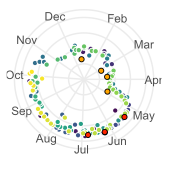reticulate package! Reticulate includes a Python engine for R Markdown that enables easy interoperability between Python and R chunks. This enables us to bring the power of Earth Engine to RStudio.


reticulate package! Reticulate includes a Python engine for R Markdown that enables easy interoperability between Python and R chunks. This enables us to bring the power of Earth Engine to RStudio.

reticulate package! Reticulate includes a Python engine for R Markdown that enables easy interoperability between Python and R chunks. This enables us to bring the power of Earth Engine to RStudio.

In Google Earth Engine we usually load an image collection first and then filter it by a date range, a region of interest and a image property with some cloud percentage estimates.
If the cloud threshold value is set too low it may happen that we throw away (filter out) to many images that could have been useful for our analysis. If we select the filter too generously, too many scenes with clouds remain. Finding a good threshold is not easy, this blog post may help to find it.

The goal of this blog post is to arrange a irregularly (with varying time intervals) spaced raster stack from Landsat into a regular time series to be used in the Breaks For Additive Season and Trend (bfast) package and function.



